Automatic gain control circuit
a gain control circuit and gain control technology, applied in the direction of electrical equipment, radio transmission, transmission, etc., can solve the problems of reducing the sensitivity of the receiving station, particularly the distortion characteristic of the signal, and reducing the level of the signal to be input to the second radio frequency amplifying circuit, so as to reduce the level of the received signal and facilitate the distortion
- Summary
- Abstract
- Description
- Claims
- Application Information
AI Technical Summary
Benefits of technology
Problems solved by technology
Method used
Image
Examples
first embodiment
[0027]An embodiment according to the present invention will be described below with reference to the drawings. FIG. 1 is a diagram showing an example of a whole structure of an automatic gain control circuit (an RF-AGC circuit 20) and a radio receiver applying the RF-AGC circuit 20 according to a first embodiment.
[0028]As shown in FIG. 1, the radio receiver according to the present embodiment is constituted by an antenna 1, a band-pass filter (BPF) 2, a first LNA 3, an antenna damping circuit 4, a second LNA 5, a frequency converting circuit 6, a BPF 7, an IF amplifier 8, a first A / D converting circuit 9, an AGC amplifier 10, a second A / D converting circuit 11, a DSP (Digital Signal Processor) 12, and an interface circuit 13. These structures (excluding the antenna 1) are integrated into a single semiconductor chip through a CMOS (Complementary Metal Oxide Semiconductor) process, for example.
[0029]The BPF 2 selectively outputs a broadcast wave signal of a specific frequency band fro...
second embodiment
[0053]Next, a second embodiment according to the present invention will be described with reference to the drawings. FIG. 3 is a diagram showing an example of a structure of an RF-AGC circuit 30 according to the second embodiment. The RF-AGC circuit 30 is used in place of the RF-AGC circuit 20 in the radio receiver shown in FIG. 1.
[0054]As shown in FIG. 3, the RF-AGC circuit 30 according to the second embodiment includes a fixed attenuating circuit 14 in addition to a first LNA 3, an antenna damping circuit 4 and a second LNA 5. The fixed attenuating circuit 14 attenuates a radio frequency signal passing through a BPF 2 by a fixed quantity of an attenuation and is connected to an input stage of the first LNA 3 (between the BPF 2 and the first LNA 3). More specifically, a first signal path is constituted by the fixed attenuating circuit 14 and the first LNA 3.
[0055]The fixed attenuating circuit 14 is constituted by a capacitor C and a switch SW which are connected in series between a...
third embodiment
[0057]Next, a third embodiment according to the present invention will be described with reference to the drawings. FIG. 4 is a diagram showing an example of a structure of an RF-AGC circuit 40 according to the third embodiment. The RF-AGC circuit 40 is used in place of the RF-AGC circuit 20 in the radio receiver shown in FIG. 1.
[0058]As shown in FIG. 4, the RF-AGC circuit 40 according to the third embodiment includes a second antenna damping circuit 15 and a bypass switch 16 in addition to a first LNA 3, an antenna damping circuit 4 and a second LNA 5. The second antenna damping circuit 15 corresponds to a second variable attenuating circuit according to the present invention and controls a radio frequency signal passing through a BPF 2 to have a degree of an attenuation which is variably set based on a fifth AGC signal. The bypass switch 16 is connected in series to the second antenna damping circuit 15 and is turned ON / OFF in response to a sixth AGC control signal supplied from a...
PUM
 Login to View More
Login to View More Abstract
Description
Claims
Application Information
 Login to View More
Login to View More - R&D
- Intellectual Property
- Life Sciences
- Materials
- Tech Scout
- Unparalleled Data Quality
- Higher Quality Content
- 60% Fewer Hallucinations
Browse by: Latest US Patents, China's latest patents, Technical Efficacy Thesaurus, Application Domain, Technology Topic, Popular Technical Reports.
© 2025 PatSnap. All rights reserved.Legal|Privacy policy|Modern Slavery Act Transparency Statement|Sitemap|About US| Contact US: help@patsnap.com



